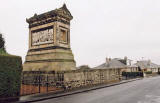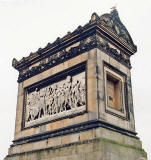|
The Miller Mausoleum 'The Craigentinny Marbles' |
|
|
William Henry Miller 1789-1848 The Miller Mausoleum is large monument, in the style of a tomb on the Appian Way in Rome. It is the last resting place of William Henry (Christie) Miller. Miller inherited Craigentinny House and estates from his father. However, he spent most of his life in England. He was Member of Parliament for Newcastle-under-Lyne from 1830. Miller died in 1848 at Craigentinny, at the age of 60, without heirs, having set aside £20,000 of his £300,000 fortune for his funeral expenses. He specified that:
There has been some speculation as to why Miller wished to be buried so deep. The book Old & New Edinburgh, published 1890, speaks of a story that made some stir at the time of Miller's death: "... he was averred to be a changeling - even a woman, a suggestion which his thin figure, weak voice, absence of all beard and some peculiarity of habit, seemed to corroborate". Perhaps, Miller's burial instructions were simply to deter body snatchers. Whatever the reason for these instructions, 80 labourers were employed to build the 40ft-deep stone-lined pit and to place a large slab at the bottom of it above the Miller's coffin. |
|
|
The Monument The Miller Mausoleum was designed by David Rhind. It was completed in 1856, in open fields on the Craigentinny estate, to the north of the Edinburgh-Portobello road between Piershill and Portobello. It is now surrounded, rather incongruously, by bungalows built in the 1930s. |
|
|
The Craigentinny Marbles The Mausoleum is popularly known as 'The Craigentinny Marbles', after the large bas relief panels, carved by Alfred Gatley. These were fixed to the north and south sides of the monument in 1867. In fact these sculptures contain no marble, but were given their name because they have been carved in the style of bas-reliefs on the Elgin Marbles held in the British Museum, London. The panels of the Craigentinny Marbles show two biblical scenes: - The Overthrow of Pharaoh in the Red Sea' |
|
|
Sources: Edinburgh Evening News:
August 14, 2002 |
| Around Edinburgh | |



